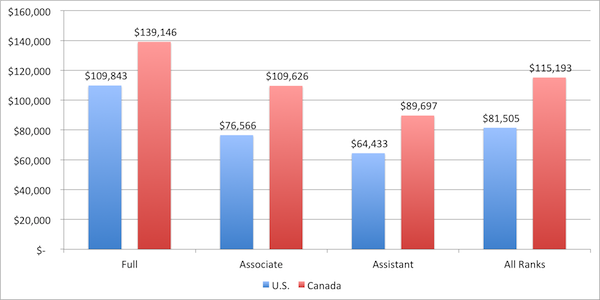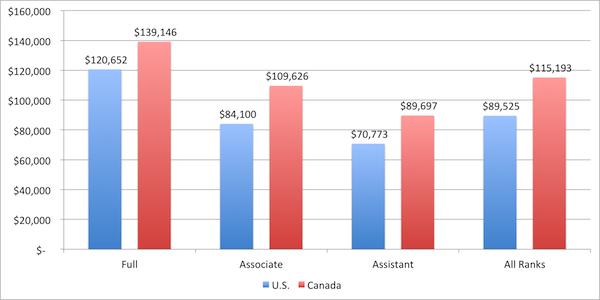Yesterday, we looked at trends in Canadian faculty salary data. But how does our compensation stack up again the United States?
Here, I take 2009-10 U.S. salary data for professors at four-year institutions from the AAUP’s Report on the Status of the Academic Profession. For Canada, I use the same data as yesterday but add professors in medical fields. I do not adjust for currency since the dollar is roughly at par. The comparison looks like this:
Canada vs. U.S. Base Salaries, 2009-10
Of course, U.S. profs are paid on a nine-month basis while our pay is based on 12 months. To compensate, American professors can pay themselves an additional two months of salary out of their research grants – if they have them. So table 1 is only an apples-to-apples comparison of people who don’t hold external grants.
I haven’t been able to find good data on grant-holders at U.S. universities. Based on NRC data, my impression is that about 65% of professors at doctoral universities hold these. My best guess (take it with a grain of salt) is that the figure is probably about 25% at “master’s” universities and maybe 5% at “baccalaureate” universities. Multiplying that out implies that in total, 44.3% of profs get a boost of 22.2% (2/9) to their base salaries, which averaged out means we should bump the American salary figure by just under 10%, making the apples-to-apples (with salt) comparison more like this:
Average Salaries, Adjusting for U.S. Summer Research Income
That’s still a 28% gap overall, though only 15% at the top end (and it’s possible that I’m understating the latter gap because I spread the 10% research bump across all ranks). No matter – it’s big enough that you can’t argue Americans are better off because of lower tax rates.
Part of the difference is due to Canadian faculty being more senior: 74% of profs in Canada are “associate” or “full,” compared to 69% in the US. I suspect part of it is also that a greater proportion of our professors teach at doctoral-equivalent universities, where pay is better. But those don’t come close to explaining the full gap – one which would be substantially larger if we confined the analysis to public universities. Our pay is higher – full stop.
What about looking at increases over time? We can do that, too, but it’s worth keeping in mind that it’s not just pay that’s increased since 2001 – so, too, has the value of the Canadian dollar. A fair comparison requires an examination of changes in both domestic and foreign currencies.
Changes in Base Salary 2001-09
To say that our ability to compete with the US for academic talent has improved lately would be a bit of an understatement, no?




 Tweet this post
Tweet this post

do usa employees have to pay same taxes as canadian employes ? what is the difference between the cost of living as houses investment in both countries and rent and other things to be mentioned